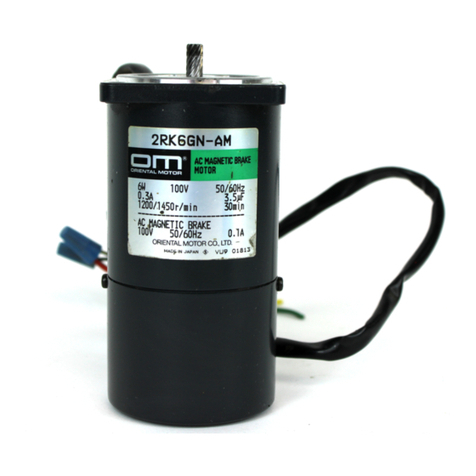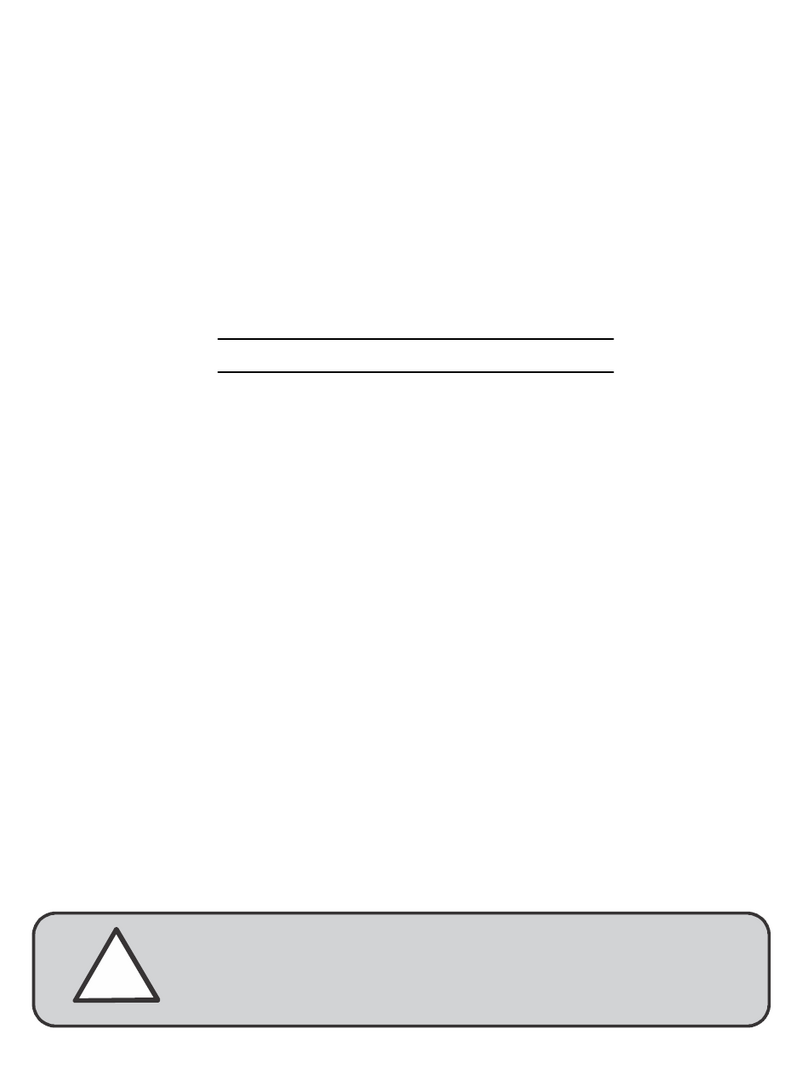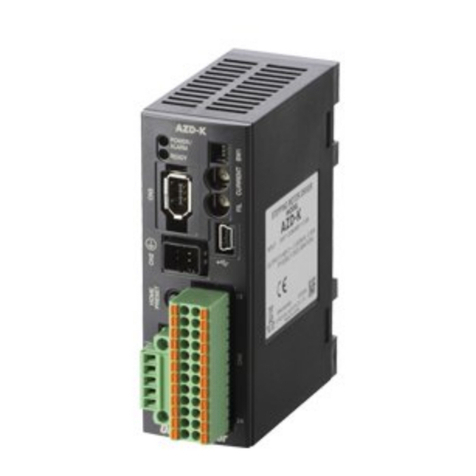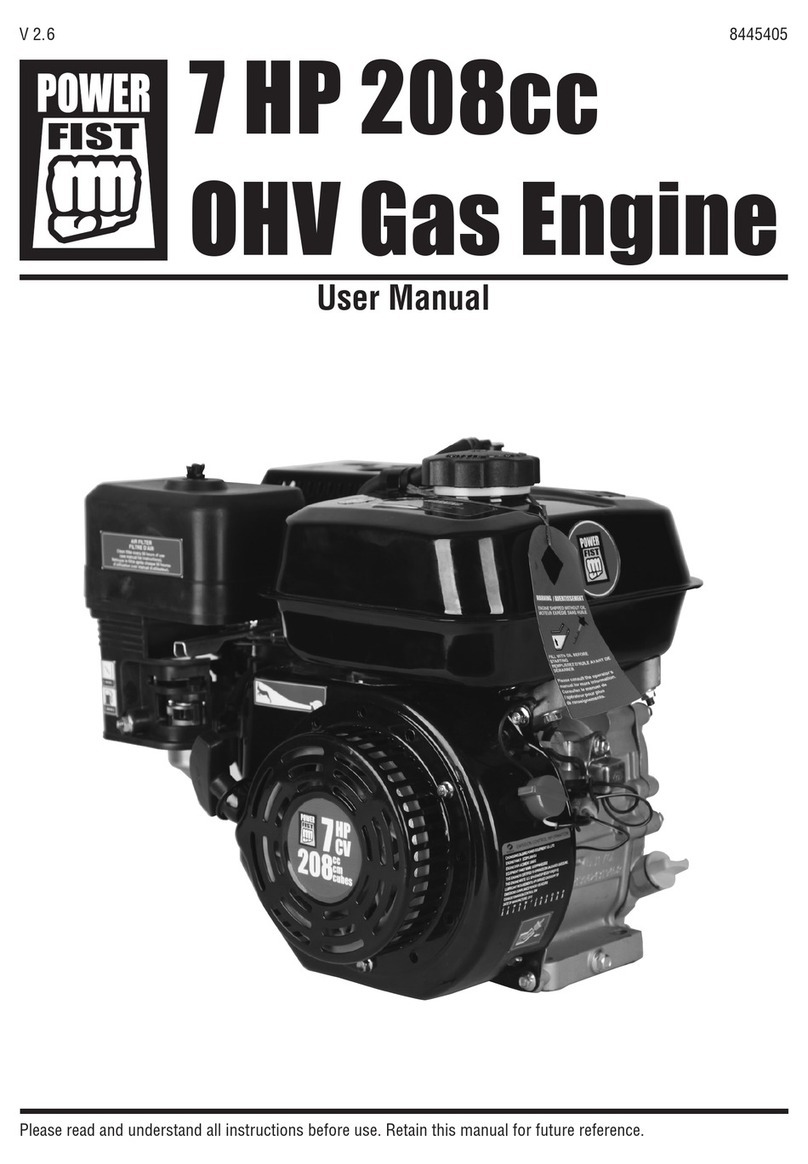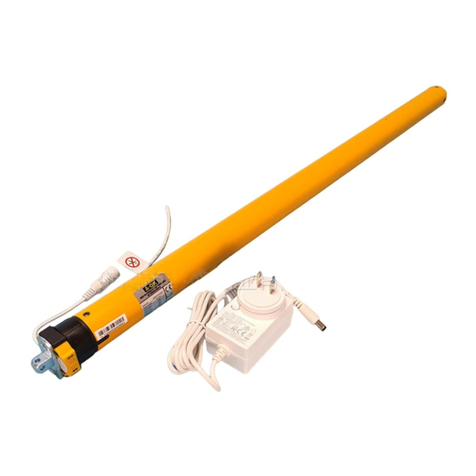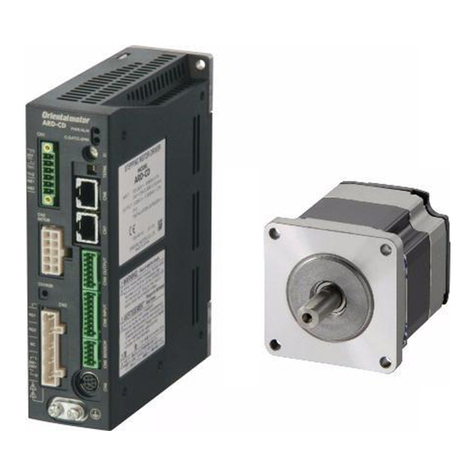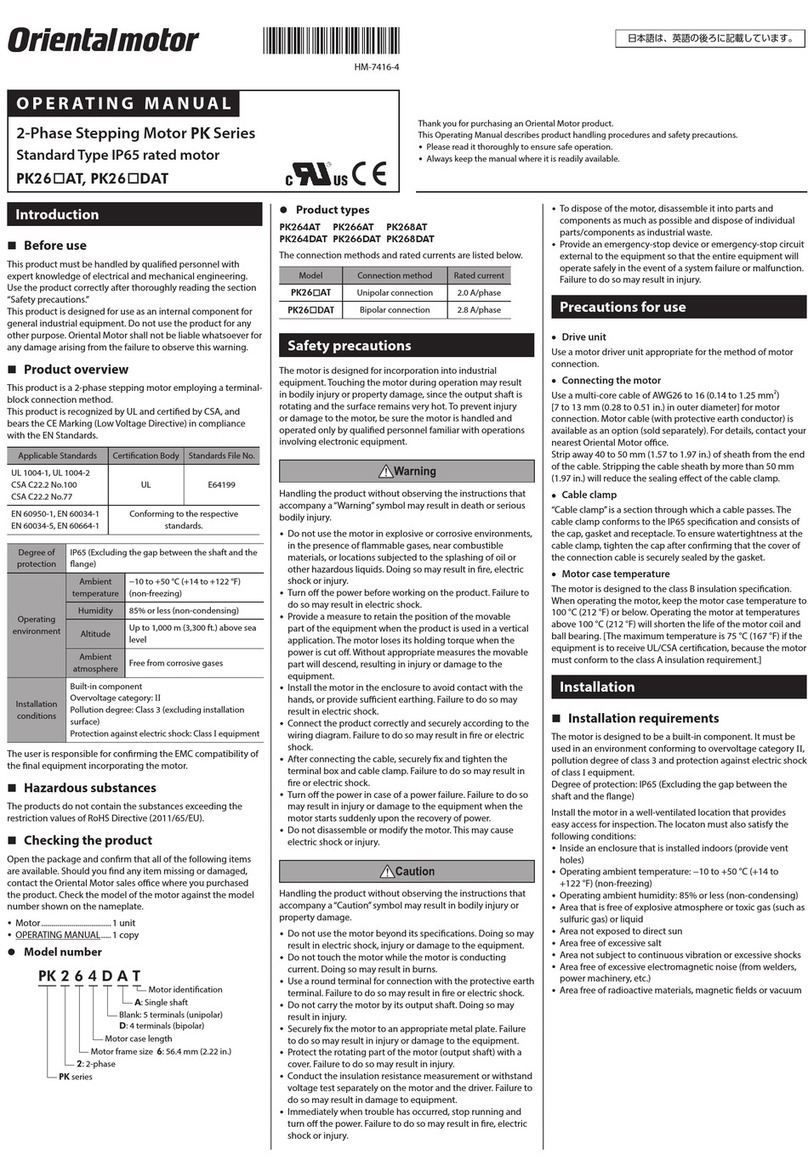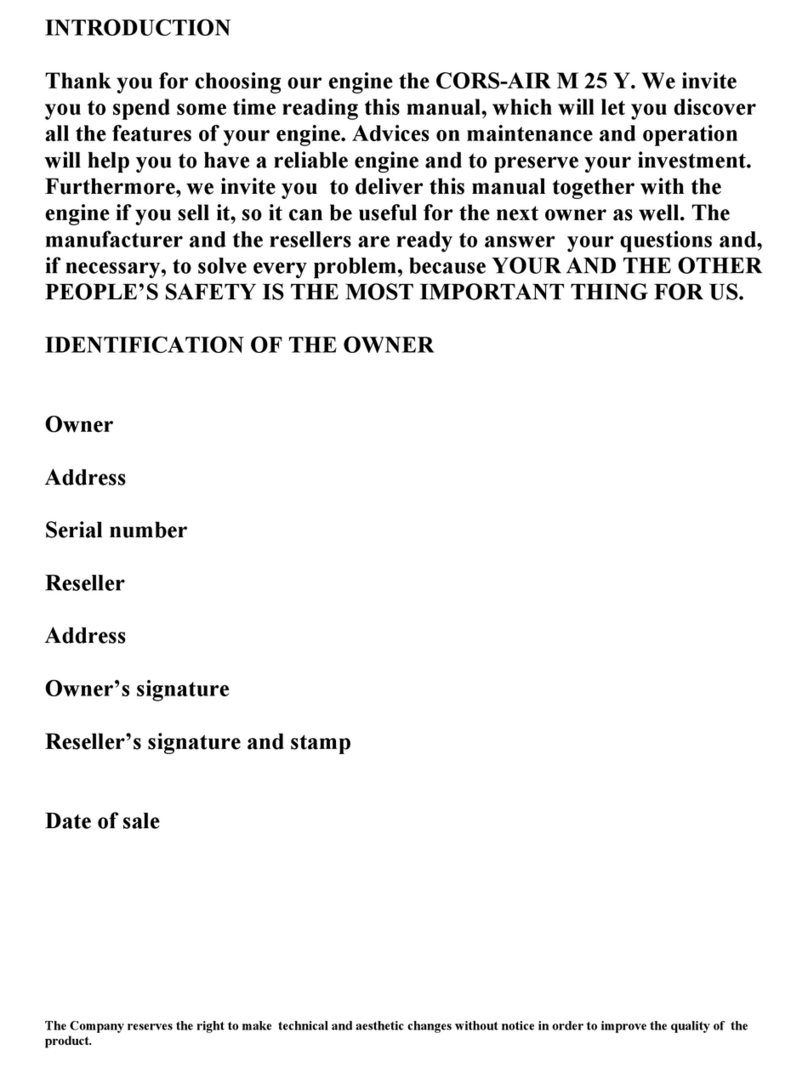Automation Technology iSV2-CAN Series User manual

User Manual Of iSV2-CAN Series
Integrated Servo Motor
Version 0.4
1

2
Introduction
Thanks for purchasing our integrated servo motor, this instruction manual provides
knowledge and attention for using this motor.
Incorrect operation may cause unexpected accident, please read this manual carefully before using
product.
We reserve the right to modify equipment and documentation without prior notice.
We won’t undertake any responsibility with customer’s any modification of product, and the warranty of
product will be cancel at the same time.
Be attention to the following warning symbol:
Warning indicates that the error operation could result in loss of life or serious injury.
Caution indicates that the error operation could result in operator injured, also make
equipment damaged.
Attention indicates that the error use may damage product and equipment.
Safety precautions
Warning
The design and manufacture of product doesn’t use in mechanic and system which have a threat to operator.
The safety protection must be provided in design and manufacture when using this product to prevent
incorrect operation or abnormal accident.
Acceptance
Caution
The product which is damaged or have fault is forbidden to use.
Transportation
Caution
The storage and transportation must be in normal condition.
Don’t stack too high, prevent falling.
The product should be packaged properly in transportation,
Don’t hold the product by the cable, motor shaft or encoder while transporting it.
The product can’t undertake external force and shock.

3
Wiring
Warning
The workers of participation in wiring or checking must possess sufficient ability do this job.
Ground the earth terminal of the motor and drive without fail.
The wiring should be connected after servo drive and servo motor installed correctly.
After correctly connecting cables, insulate the live parts with insulator.
Caution
The wiring must be connected correctly and steadily, otherwise servo motor may run incorrectly, or damage
the equipment.
We mustn’t connect capacitors, inductors or filters between servo motor and servo drive.
The wire and temperature-resistant object must not be close to radiator of servo drive and motor.
The freewheel diode which connect in parallel to output signal DC relay mustn’t connect reversely.
Debugging and running
Caution
Make sure the servo drive and servo motor installed properly before power on, fixed steadily, power
voltage and wiring correctly.
The first time of debugging should be run without loaded, debugging with load can be done after
confirming parameter setting correctly, to prevent mechanical damage because of error operation.
Caution
Install a emergency stop protection circuit externally, the protection can stop running immediately to
prevent accident happened and the power can be cut off immediately.
The run signal must be cut off before resetting alarm signal, just to prevent restarting suddenly.
The servo drive must be matched with specified motor.
Don’t power on and off servo system frequently, just to prevent equipment damaged.
Forbidden to modify servo system.
Fault Processing
Caution
The reason of fault must be figured out after alarm occurs, reset alarm signal before restart.
Keep away from machine, because of restart suddenly if the drive is powered on again after momentary
interruption(the design of the machine should be assured to avoid danger when restart occurs)
System selection
Attention
The rate torque of servo motor should be larger than effective continuous load torque.
The ratio of load inertia and motor inertia should be smaller than recommended value.
The servo drive should be matched with servo motor.

4
Table of Contents
Introduction.......................................................................................................................................................... 2
Chapter 1 Introduction.......................................................................................................................................... 7
1.1 Product Introduction............................................................................................................................... 7
1.1.1 Specification and feature............................................................................................................. 7
1.1.2 Part Numbering Information ....................................................................................................... 8
1.2 Inspection of product.............................................................................................................................. 8
Chapter 2 Installation ........................................................................................................................................... 9
2.1 Storage and Installation Circumstance................................................................................................... 9
2.2 Servo Drive Installation.......................................................................................................................... 9
Chapter 3 Wiring................................................................................................................................................ 10
3.1 Wiring................................................................................................................................................... 10
3.1.1 Wire Gauge................................................................................................................................ 10
3.1.2 Wiring........................................................................................................................................ 12
3.2 Drive Terminals Function..................................................................................................................... 13
3.2.1 Control Signal Port-CN1 Terminal............................................................................................ 13
3.2.2 Power Port................................................................................................................................. 14
3.2.3 Communication Port.................................................................................................................. 14
3.2.4 CAN bus connector ................................................................................................................... 14
3.2.5 CAN Node-ID and Baud rate switch......................................................................................... 14
3.3 I/O Interface Principle.......................................................................................................................... 15
3.3.1 Digital Input Interface ............................................................................................................... 15
3.3.2 Digital Output Interface............................................................................................................. 15
Chapter 4 Parameter........................................................................................................................................... 18
4.1 Parameter List ...................................................................................................................................... 18
4.1.1 Drive Parameters (Group 2000h) .............................................................................................. 18
4.1.2 Manufacturer Parameters (Group 5000h).................................................................................. 21
4.1.3 Device Profile Parameters (Group 6000h) ................................................................................ 23
4.2 Parameters Function............................................................................................................................. 25
4.2.1【Class 0】Basic Setting........................................................................................................... 25
4.2.2【Class 1】Gain Adjust ............................................................................................................. 29
4.2.3【Class 2】Vibration Suppression............................................................................................. 33
4.2.4【Class 3】Velocity/ Torque Control......................................................................................... 35
4.2.5【Class 4】I/F Monitor Setting ................................................................................................. 36
4.2.6【Class 5】Extended Setup ....................................................................................................... 41
4.2.7【Class 6】Special Setup........................................................................................................... 44
4.2.8【Class 7】Factory setting......................................................................................................... 46
4.3 402 Parameters Function...................................................................................................................... 47
Chapter 5 CANopen........................................................................................................................................... 52
5.1 CAN Interface ...................................................................................................................................... 52
5.2 CANopen protocol ............................................................................................................................... 52
5.2.1 CANopen frame ........................................................................................................................ 52
5.2.2 CANopen objects ...................................................................................................................... 53

5
5.3 NMT..................................................................................................................................................... 54
5.3.1 NMT services ............................................................................................................................ 55
5.3.1 NMT error control..................................................................................................................... 55
5.4 SDO...................................................................................................................................................... 57
5.5 PDO...................................................................................................................................................... 58
5.6 SYNC................................................................................................................................................... 59
5.7 EMCY.................................................................................................................................................. 59
Chapter 6 Trial Run............................................................................................................................................ 61
6.1 Inspection Before trial Run .................................................................................................................. 61
6.2 iSV2-CAN motion control procedure .................................................................................................. 61
6.3 CIA402 State Machine ........................................................................................................................ 62
6.4 Common Functions for All Modes....................................................................................................... 63
6.4.1 Motor Rotation Direction .......................................................................................................... 63
6.2.2 Drive Stop.................................................................................................................................. 63
6.4.3 Electronic Gear Ratio................................................................................................................ 63
6.4.4 Control Word............................................................................................................................. 64
6.4.5 Status Word................................................................................................................................ 65
6.4.6 Drive Enable.............................................................................................................................. 66
6.5 Profile position mode ........................................................................................................................... 66
6.5.1 Controlword in profile position mode ....................................................................................... 66
6.5.2 Statusword in profile position mode.......................................................................................... 67
6.5.3 Related objects .......................................................................................................................... 68
6.5.4 Example of profile position mode ............................................................................................. 68
6.6 Profile velocity mode ........................................................................................................................... 69
6.6.1 Controlword in profile velocity mode ....................................................................................... 69
6.6.2 Statusword in profile velocity mode.......................................................................................... 69
6.6.3 Related objects .......................................................................................................................... 70
6.6.4 Example of profile velocity mode ............................................................................................. 70
6.7 Profile torque mode.............................................................................................................................. 71
6.7.1 Controlword in profile torque mode.......................................................................................... 71
6.7.2 Statusword in profile torque mode ............................................................................................ 71
6.7.3 Related objects .......................................................................................................................... 72
6.7.4 Example of profile torque mode................................................................................................ 72
6.8 Homing mode....................................................................................................................................... 73
6.8.1 Controlword in profile homing mode........................................................................................ 73
6.8.2 Statusword in profile homing mode .......................................................................................... 73
6.8.3 Related objects .......................................................................................................................... 74
6.8.4 Example of homing mode ......................................................................................................... 74
6.8.5 Homing Method ........................................................................................................................ 75
6.9 Security Features.................................................................................................................................. 90
6.9.1 BRK-OFF output....................................................................................................................... 90
6.9.2 Servo stop mode........................................................................................................................ 91
6.9.3 Emergency stop function........................................................................................................... 91
6.10 Inertia ratio identification................................................................................................................... 91

6
6.10.1 On-line inertia ratio identification........................................................................................... 92
6.10.2 Motion Studio inertia ratio identification ................................................................................ 92
6.11 Vibration Suppression......................................................................................................................... 93
6.12 Friction torque compensation............................................................................................................. 95
6.13 Regenerative resister setting............................................................................................................... 95
Chapter 7 Alarm and Processing ........................................................................................................................ 97
7.1 Alarm List............................................................................................................................................. 97
7.2 Alarm Processing Method .................................................................................................................... 99
Chapter 8 Product Accessory ........................................................................................................................... 107
8.1 Accessory selection ............................................................................................................................ 107

7
Chapter 1 Introduction
1.1 Product Introduction
iSV2-CAN integrated servo is a special motion control product designed for machines and applications
that request a best balance between outstanding and reasonable cost.
Based on CIADS 301+DSP 402 sub-protocol, it can be seamlessly connected to the controller/drive that
supports this standard protocol.
Basic specification
Up to 750watt
Frame size : 60mm, 80mm
Voltage input : 24-60VDC
Encoder : 17bit incremental
Motor with or without brake
2.5 –3 times overload
4 programmable input
2 programmable output
RS232 for configuration
CANopen Communication
Up to 128 axes supported in one network
Link Layer Protocol : CAN Field-bus
Application Layer Protocol : CANopen Protocol
CAN-ID type : CAN 2.0A
Communication Rate : 1M/500k/250k/100k/50k/20k bit/s
Sub-protocol :DS301 V4.02 , DSP 402 V2.0
PDO Transmission Modes : Time trigger/event trigger/asynchronization/synchronization
Control mode : profile position, profile velocity , profile torque , homing
1.1.1 Specification and feature
Part Number
iSV2-CAN6020V24*
iSV2-CAN6020V48*
iSV2-CAN6040V48*
iSV2-CAN8075V48*
Rated Power(W)
200
200
400
750
Rated Torque(Nm)
0.64
0.64
1.27
2.39
Peak Torque(Nm)
1.92
1.92
3.81
7.17
Rated Speed(rpm)
3000
3000
3000
3000
Peak Speed(rpm)
4000
4000
4000
4000
Rated Voltage(VDC)
24
48
48
48
Input Voltage(VDC)
24~60
24~60
24~60
24~60
Continuous Current(Arms)
11
6.5
10
19
Peak Current(Arms)
34
20
28
57
Logic Signal Current(mA)
10
10
10
10
Isolation Resistance(MΩ)
100
100
100
100
Weight(kg)
0.93(1.32)
0.93(1.32)
1.26(1.65)
2.52(3.19)
Control method
IGBT PWM sinusoidal Wave Drive
Overload
250% ~ 300%
Brake resistor
External connection
Protection rank
IP20

8
Features
Drive model
iSV2-CAN6020*
iSV2-CAN6040*
iSV2-CAN8075*
Modes of operation
Profile Position/Profile Velocity/Profile Torque
Command source
Over the Network
Inputs/Outputs
4 programmable single-end inputs(24V);
2 programmable single-end outputs.
Brake Output (24vdc)
√
Feedback Supported
17bit Incremental
Communication
CANopen , RS-232 for tuning
1.1.2 Part Numbering Information
iSV2- CAN 6040 V48 G
H : Motor without brake, G: Motor with brake
Voltage,24: 24V , 48: 48V
Maximum Output Power :
6020: 60mm frame size, 200W
6040: 60mm frame size, 400W
8075: 80mm frame size, 750W
RS: RS-485(Pulse+Dir/RS-485)
CAN: CANopen
iSV2 servo motor ( 24-60Vdc)
1.2 Inspection of product
Check the following thing before using the products :
a. Check if the product is damaged or not during transportation.
b. Check if the servo drive & motor are complete or not.
c. Check the packing list if the accessories are complete or not

9
Chapter 2 Installation
2.1 Storage and Installation Circumstance
Table 2.1 Servo Motor Storage Circumstance Requirement
Item
iSV2 series motor
Temperature
-20-80℃
Humility
Under 90%RH (free from condensation)
Atmospheric environment
Indoor(no exposure)no corrosive gas or flammable gas, no oil or dust
Altitude
Lower than 1000m
Vibration
Less than 0.5G (4.9m/s2) 10-60Hz (non-continuous working)
Protection level
IP20
Table 2.2 Servo Motor Installation Circumstance Requirement
Item
iSV2 series motor
Temperature
0-80℃
Humility
Under 90%RH(free from condensation)
Atmospheric environment
Indoor(no exposure)no corrosive gas or flammable gas, no oil or dust
Altitude
Lower than 1000m
Vibration
Less than 0.5G (4.9m/s2) 10-60Hz (non-continuous working)
Protection level
IP20(no protection)
2.2 Servo Drive Installation
Notice
Must install in control cabinet with sufficient safeguarding grade.
Must install with specified direction and intervals, and ensure good cooling condition.
Don’t install them on inflammable substance or near it to prevent fire hazard.
Notice
Don’t hold the product by the cable, motor shaft or encoder while transporting it.
No knocking motor shaft or encoders, prevent motor by vibration or shock.
The motor shaft can’t bear the load beyond the limits.
Motor shaft does not bear the axial load, radial load, otherwise you may damage the motor.
Use a flexible with high stiffness designed exclusively for servo application in order to make a radial
thrust caused by micro misalignment smaller than the permissible value.
Install must be steady, prevent drop from vibrating.

10
Chapter 3 Wiring
Warning
The workers of participation in wiring or checking must possess sufficient ability do this job.
The wiring and check must be going with power off after five minutes.
Caution
Ground the earth terminal of the motor and drive without fail.
The wiring should be connected after servo drive and servo motor installed correctly
3.1 Wiring
3.1.1 Wire Gauge
(1)Power supply terminal TB
●Wiring Diameter:
Drive
Wiring diameter (mm2/AWG)
Vdc, GND
PE
iSV2-CAN6020V24*
AWG16
AWG16
iSV2-CAN6020V48*
AWG16
AWG16
iSV2-CAN6040V48*
AWG16
AWG16
iSV2-CAN8075V48*
AWG14
AWG14
● Grounding: The grounding wire should be as thick as possible, servo motor the PE terminal point ground,
ground resistance <100 Ω.
●Use noise filter to remove external noise from the power lines and reduce an effect of the noise generated
by the servo drive.
● Install fuse (NFB) promptly to cut off the external power supply if drive error occurs.
(2) The control signal CN1
● Diameter: shielded cable (twisting shield cable is better), the diameter ≥ 0.14mm2(AWG24-26), the shield
should be connected to FG terminal.
● Length of line: cable length should be as short as possible and control CN1 cable is no more than 3 meters,
the CN2 cable length of the feedback signal is no more than 10 meters.
● Wiring: be away from the wiring of power line, to prevent interference input.
●Install a surge absorbing element for the relevant inductive element (coil), DC coil should be in parallel
connection with freewheeling diode reversely; AC coil should be in parallel connection with RC snubber
circuit.
(3) Regenerative resistor
When the torque of the motor is opposite to the direction of rotation (common scenarios such as deceleration,
vertical axis descent, etc.), energy will feedback from the load to the drive. At this time, the energy feedback is
first received by the capacitor in the drive, which makes the voltage of the capacitor rise. When it rises to a
certain voltage value, the excess energy needs to be consumed by the regenerative resistance
The recommended regenerative resistance specifications for the iSV2 series are as follows:
Drive
Recommend resister value (Ω)
Recommend resister power (W)
iSV2-CAN6020V24*
10
50
iSV2-CAN6020V48*
10
50

11
iSV2-CAN6040V48*
10
50
iSV2-CAN8075V48*
10
100
Method for select regenerative resistance specification
Firstly, use the built-in resistance of the drive to run for a long time to see if it can meet the requirements:
ensure that the drive temperature d33<60℃, the braking circuit does not alarm (Regeneration load factor
d14<80), and the drive does not report overvoltage error
If the drive temperature is high, try to reduce the regenerative energy power, or external resistance of the
same specification (in this case, cancel the built-in resistance).
If the brake resistance burns out, try to reduce the regenerative energy power, or put an external resistance
of the same specification or even more power (in this case, cancel the built-in resistance).
If d14 is too large or accumulates too fast, it means that the regenerative energy is too large, and the
built-in resistance cannot consume the generated energy, the regenerative energy power will be reduced,
or the external resistance with higher resistance value or power will be reduced.
If an overvoltage error is reported by the drive, the regenerative energy power is reduced, or a resistance
with a smaller external resistance, or a parallel resistance.
The recommended regenerative resistance specifications for the iSV2 series are as follows:
10Ω+/-5%, 100w RXFB-1,
Part num Code : 10100469
Attention
Match the colors of the motor lead wires to those of the corresponding motor output terminals (U.V.W)
Never start nor stop the servo motor with this magnetic contactor.

12
3.1.2 Wiring
CN1
5
COM_IN
DI3
DI4
12~24Vdc
(input)
RS232
1
2
3
270Ω
4
6
7
Vdc
GND
DC Power Supply
+
-
270Ω
4.7K
4.7K
4.7K
4.7K
9
8
COM_OUT
24Vdc
(output)
10
11
12
DO1
DO2
BR+
BR-
Regenerative
resistor
NC
DI5
DI6
CAN*2
Figure 3.1 Position Control Mode Wiring
Notes:
1. 4 digital inputs DI3~DI6, support NPN and PNP connection, recommend 12~24V input signal.
2. 2 digital outputs DO1~DO2, support NPN and PNP connection, recommend 24V output signal.

13
3.2 Drive Terminals Function
Port
Function
CN1
Control Signal Port
CN2
Power Port
CN3
RS232 Communication Port
CN4
CAN Communication Port
RCS
CAN slave axis ID
SW1~4
CAN Baud rate \ Terminal resistance
3.2.1 Control Signal Port-CN1 Terminal
Table 3.1 Signal Explanation of Control Signal Port-CN1
CN1
Pin
Signal
IO
Detail
CN1
1
NC
Input
Reserved
2
NC
Input
3
NC
Input
Reserved
4
NC
Input
5
COMI
Input
Power supply positive terminal of the external input control signal, 12V
~ 24V
6
DI3
Input
Digital input signal 3, default value is E-STOP signal, low level
available in default , max voltage is 24V input 20KHz
7
DI4
Input
Digital input signal 4, default value is homing switch
signal(HOME-SWITCH) , low level available in default , max voltage
is 24V input 20KHz
8
DI5
Input
Digital input signal 5, default value is Positive limit switch
signal(POT), low level available in default , max voltage is 24V input
20KHz
9
DI6
Input
Digital input signal 6, default value is Negative limit switch signal
(NOT), low level available in default , max voltage is 24V input 20KHz
10
DO1
Output
Digital output signal 1 , default value is alarm output,24V, <100mA
11
DO2
Output
Digital output signal 2 , default value is servo-ready output,24V,
<100mA
12
COMO
Output
Digital output signal commonality ground, 24V

14
3.2.2 Power Port
CN2
Pin
Signal
Description
CN2
1
DC+
Power Supply Input (Positive)24-60VDC recommended. Please leave reasonable
reservation for voltage fluctuation and back-EMF during deceleration.
2
DC-
Power Ground (Negative)
3
RBR+
Regenerative resistor +
4
RBR-
Regenerative resistor -
The recommend resistor for most application is 10Ω+/-5%, 100watt
Leadshine can provide resistor: RXFB-1, Part num Code : 10100469
3.2.3 Communication Port
CN3
Pin
Signal
RS232
1
5V
2
TX
3
GND
4
RX
3.2.4 CAN bus connector
CN4
Pin
Signal
CAN
1
CANH
2
CANL
3
GND
4
PE
3.2.5 CAN Node-ID and Baud rate switch
RCS
NO
CAN Node-ID
NO
CAN Node-ID
0
Pr0.23
Default =16
8
8
1
1
9
9
2
2
A
10
3
3
B
11
4
4
C
12
5
5
D
13
6
6
E
14
7
7
F
15
If switch S1=0, then Pr0.23 valid.
If switch S1=1~F, S1 switch valid in higher priority than Pr0.23

15
CAN Baud rate
SW1
SW2
Pr0.24
Default =1MHz
off
off
500 KHz
on
off
250 KHz
off
on
125 KHz
on
on
If SW1 and SW2 OFF, then Pr0.24 valid
If SW1 or SW2 ON, then these switch valid in higher priority than Pr0.24
SW3: CAN terminal resistor
SW3=off,disconnect the terminal resistance
SW3=on,connect the terminal resistance
SW4:CAN Node-ID selection(High Bit)
SW4=off, High Bit =0, CAN Node-ID=RCS
SW4=on, High Bit =1, CAN Node-ID =16+RCS
3.3 I/O Interface Principle
3.3.1 Digital Input Interface
4.7K
COMI
DI3
Figure 3-2 Digital Input Interface
(1) The user provide power supply, DC 12-24V, current≥100mA
(2) Notice: if current polar connect reversely, servo motor doesn’t run.
3.3.2 Digital Output Interface
COMO
DO1
Single-ended output
Figure 3-3 Switch Output Interface
(1) 2 digital single-ended outputs DO1~DO2, support NPN and PNP connection, recommend 24V output
signal.
(2) If the load is inductive loads relays, etc., there must be anti-parallel freewheeling diode across the load. If
the freewheeling diode is connected reversely, the servo drive is damaged.
Digital Input function allocation
Pr4.02
Name
Input selection DI3
Mode
F
Range
0~00FFFFFFh
Unit
—
Default
0x14
Index
2402h
Pr4.03
Name
Input selection DI4
Mode
F
Range
0~00FFFFFFh
Unit
—
Default
0x16
Index
2403h

16
Pr4.04
Name
Input selection DI5
Mode
F
Range
0~00FFFFFFh
Unit
—
Default
0x01
Index
2404h
Pr4.05
Name
Input selection DI6
Mode
F
Range
0~00FFFFFFh
Unit
—
Default
0x02
Index
2405h
Assign functions to digital inputs.
This parameter use 16 binary system to set up the values,
For the function number, please refer to the following table.
Signal
Symbol
Setup Value
0x60FD(bit)
Normally
open
Normally
closed
Invalid
—
00h
Do not setup
×
Positive direction over-travel
inhibition input
POT
01h
81h
1
Negative direction over-travel
inhibition input
NOT
02h
82h
0
Alarm clear input
A-CLR
04h
Do not setup
Forced alarm input
E-STOP
14h
94h
HOME-SWITCH
HOME-SWITCH
16h
96h
2
·Normally open means input signal comes from external controller or component, for example: PLC .
·Normally closed means input signal comes from drive internally.
·Don’t setup to a value other than that specified in the table .
·Don’t assign specific function to 2 or more signals. Duplicated assignment will cause Err210 I/F input
multiple assignment error 1or Err211 I/F input multiple assignment error 2.
·E-STOP:Associated parameter Pr4.43
I/O input digital filtering
Pr5.15*
Name
I/O reading filter
Mode
F
Range
0~255
Unit
0.1ms
Default
0
Index
2515h
I/O input digital filtering; higher setup will arise control delay.
Digital Output function allocation
Pr4.10
Name
Output selection DO1
Mode
F
Range
0~00FFFFFFh
Unit
—
Default
0x01
Index
2410h
Pr4.11
Name
Output selection DO2
Mode
F
Range
0~00FFFFFFh
Unit
—
Default
0x02
Index
2411h

17
Assign functions to digital outputs.
For the function number, please refer to the following table.
Signal name
Symbol
Setup value
Normally open
Normally closed
Master control output
—
00h
Do not setup
Alarm output
Alm
81h
01h
Servo-Ready output
S-RDY
02h
82h
Eternal brake release signal
BRK-OFF
03h
83h
Positioning complete output
INP
04h
84h
At-speed output
AT-SPPED
05h
85h
Torque limit signal output
TLC
06h
86h
Zero speed clamp detection output
ZSP
07h
87h
Velocity coincidence output
V-COIN
08h
88h
Positional command ON/OFF output
P-CMD
0Bh
8Bh
Speed limit signal output
V-LIMIT
0Dh
8Dh
Speed command ON/OFF output
V-CMD
0Fh
8Fh
Servo enable state output
SRV-ST
12h
92h
Homing process finish
HOME-OK
22h
A2h
·Normally open:Active low
·Normally closed:Active high
·Don’t setup to a value other than that specified in the table .
·Pr4.10~Pr4.11 correspond to DO1~DO2 respectively.

18
Chapter 4 Parameter
4.1 Parameter List
4.1.1 Drive Parameters (Group 2000h)
Mode
Parameter Number
Name
CANopen
Address
Parameters
Classify
Num
F
[Class 0]
Basic
setting
00
MFC function
2000h
Pr_000
F
01
control mode setup
2001h
Pr_001
F
02
real-time auto-gain tuning
2002h
Pr_002
F
03
selection of machine
stiffness at real-time
auto-gain tuning
2003h
Pr_003
F
04
Inertia ratio
2004h
Pr_004
06
Rotation direction setup
2006h
Pr_006
PP
PV
HM
08
Command pulse per one
motor revolution
2008h
Pr_008
F
13
1st torque limit
2013h
Pr_023
PP
HM
14
position deviation excess
setup
2014h
Pr_014
15
Absolute encoder setup
2015h
Pr_015
F
16
External regenerative
resistance value
2016h
Pr_016
F
17
External regenerative
resistance power value
2017h
Pr_017
F
23
CAN Node ID
2023h
Pr_023
F
24
CAN baud rate
2024h
Pr_024
25
Synchronous
compensation time 1
2025h
Pr_025
26
Synchronous
compensation time 2
2026h
Pr_026
PP
HM
[Class 1]
Gain
Adjust
00
1st gain of position loop
2100h
Pr_100
F
01
1st gain of velocity loop
2101h
Pr_101
F
02
1st time constant of
velocity loop integration
2102h
Pr_102
F
03
1st filter of velocity
detection
2103h
Pr_103
F
04
1st time constant of torque
filter
2104h
Pr_104
PP
HM
05
2nd gain of position loop
2105h
Pr_105
F
06
2nd gain of velocity loop
2106h
Pr_106
F
07
2nd time constant of
velocity loop integration
2107h
Pr_107
F
08
2nd filter of velocity
detection
2108h
Pr_108
F
09
2nd time constant of
torque filter
2109h
Pr_109
PP
HM
10
Velocity feed forward gain
2110h
Pr_110
PP
HM
11
Velocity feed forward
filter
2111h
Pr_111
PP
PV
HM
12
Torque feed forward gain
2112h
Pr_112

19
Mode
Parameter Number
Name
CANopen
Address
Parameters
Classify
Num
PP
PV
HM
13
Torque feed forward filter
2113h
Pr_113
F
15
Control switching mode
2115h
Pr_115
F
17
Control switching level
2117h
Pr_117
F
18
Control switch hysteresis
2118h
Pr_118
F
19
Gain switching time
2119h
Pr_119
F
37
Special register
2137h
Pr_137
[Class 2]
Vibration
Restrain
Function
00
adaptive filter mode setup
2200h
Pr_200
F
01
1st notch frequency
2201h
Pr_201
F
02
1st notch width selection
2202h
Pr_202
F
03
1st notch depth selection
2203h
Pr_203
F
04
2nd notch frequency
2204h
Pr_204
F
05
2nd notch width selection
2205h
Pr_205
F
06
2nd notch depth selection
2206h
Pr_206
F
07
3rd notch frequency
2207h
Pr_207
14
1st damping frequency
2214h
Pr_214
15
1st damping filter setup
2215h
Pr_215
PP
HM
22
Positional command
smooth filter
2222h
Pr_222
PP
HM
23
Positional command FIR
filter
2223h
Pr_223
PV
[Class 3]
Speed,
Torque
Control
12
time setup acceleration
2312h
Pr_312
PV
13
time setup deceleration
2313h
Pr_313
PV
14
Sigmoid acceleration/
deceleration time setup
2314h
Pr_314
PV
16
Speed zero-clamp level
2316h
Pr_316
23
Speed mode zero speed
static
2323h
Pr_323
F
[Class 4]
I/F
Monitor
Setting
00
input selection DI1
2400h
Pr_400
F
01
input selection DI2
2401h
Pr_401
F
02
input selection DI3
2402h
Pr_402
F
03
input selection DI4
2403h
Pr_403
F
04
input selection DI5
2404h
Pr_404
F
05
input selection DI6
2405h
Pr_405
F
10
output selection DO1
2410h
Pr_410
F
11
output selection DO2
2411h
Pr_411
PP
HM
31
Positioning complete
range
2431h
Pr_431
PP
HM
32
Positioning complete
output setup
2432h
Pr_432
PP
HM
33
INP hold time
2433h
Pr_433
F
34
Zero-speed
2434h
Pr_434
PV
35
Speed coincidence range
2435h
Pr_435
PV
36
At-speed
2436h
Pr_436
F
37
Mechanical brake action
setting when stopping
2437h
Pr_437
F
38
Mechanical brake action
setting
2438h
Pr_438
F
39
Brake release speed setup
2439h
Pr_439
F
43
E-stop function active
2443h
Pr_443
F
04
Drive inhibit input setup
2504h
Pr_504
F
06
Sequence at servo-off
2506h
Pr_506

20
Mode
Parameter Number
Name
CANopen
Address
Parameters
Classify
Num
F
[Class 5]
Extended
Setup
08
Main power off LV trip
selection
2508h
Pr_508
F
09
Main power off detection
time
2509h
Pr_509
10
Dynamic braking mode
2510h
Pr_510
11
Torque setup for
emergency stop
2511h
Pr_511
F
12
Over-load level setup
2512h
Pr_512
F
13
Over-speed level setup
2513h
Pr_513
PP
HM
20
Position setup unit select
2520h
Pr_520
F
21
Selection of torque limit
2521h
Pr_521
F
22
2nd torque limit
2522h
Pr_522
33
Touch probe 1 signal
compensation time
2533h
Pr_533
34
Touch probe 2 signal
compensation time
2534h
Pr_534
37
Torque saturation alarm
detection time
2537h
Pr_537
39
3rd torque limit
2539h
Pr_539
[Class 6]
Special
Setup
01
Encoder zero position
compensation
2601h
Pr_601
PP
HM
04
JOG trial run command
speed
2604h
Pr_604
PP
HM
05
Position 3rd gain valid
time
2605h
Pr_605
PP
HM
06
Position 3rd gain scale
factor
2606h
Pr_606
F
07
Torque command
additional value
2607h
Pr_607
F
08
Positive direction torque
compensation value
2608h
Pr_608
F
09
Negative direction torque
compensation value
2609h
Pr_609
11
Current response setup
2611h
Pr_611
12
Setting of torque limit for
zero correction of encoder.
2612h
Pr_612
F
13
2nd inertia ratio
2613h
Pr_613
F
14
Emergency stop time at
alarm
2614h
Pr_614
20
distance of trial running
2620h
Pr_620
21
waiting time of trial
running
2621h
Pr_621
22
cycling times of trial
running
2622h
Pr_622
25
Acceleration of trial
running
2625h
Pr_625
26
Mode of trial running
2626h
Pr_626
34
Frame error window time
2634h
Pr_634
35
Frame error window
2635h
Pr_635
This manual suits for next models
3
Table of contents
Popular Engine manuals by other brands

Oriental motor
Oriental motor World K Series operating manual
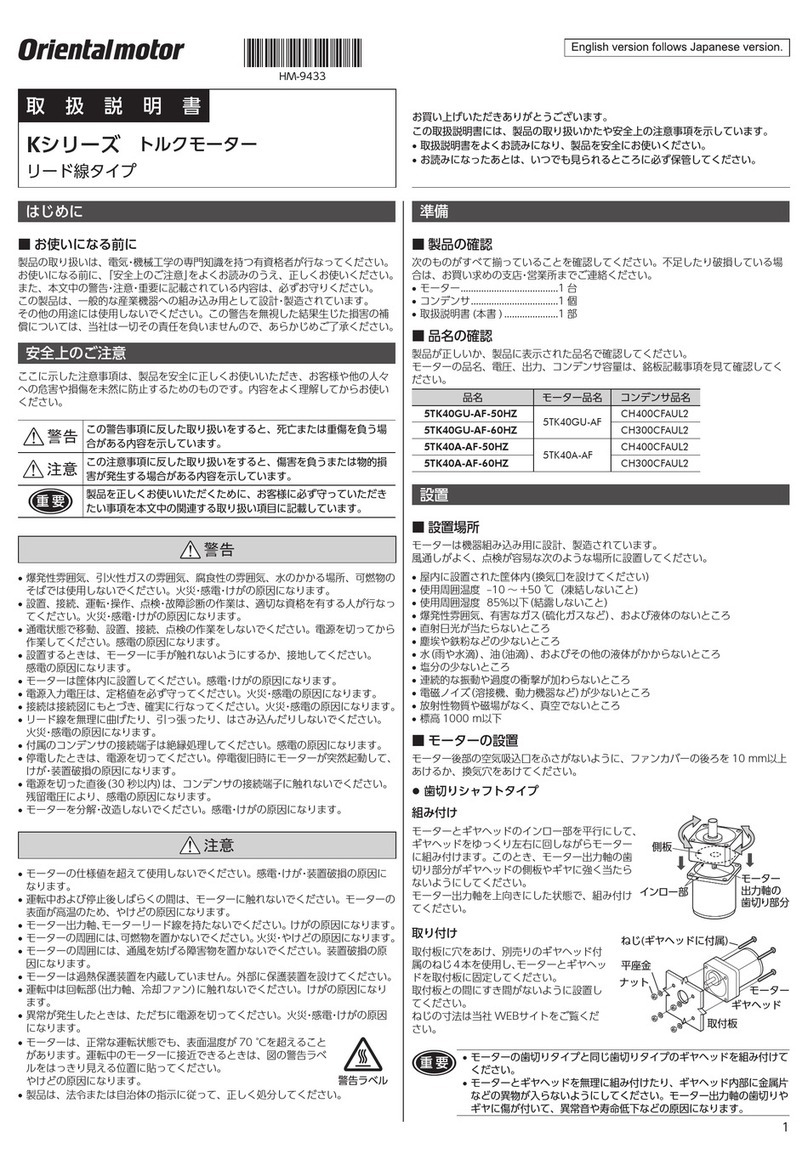
Oriental motor
Oriental motor K Series operating manual
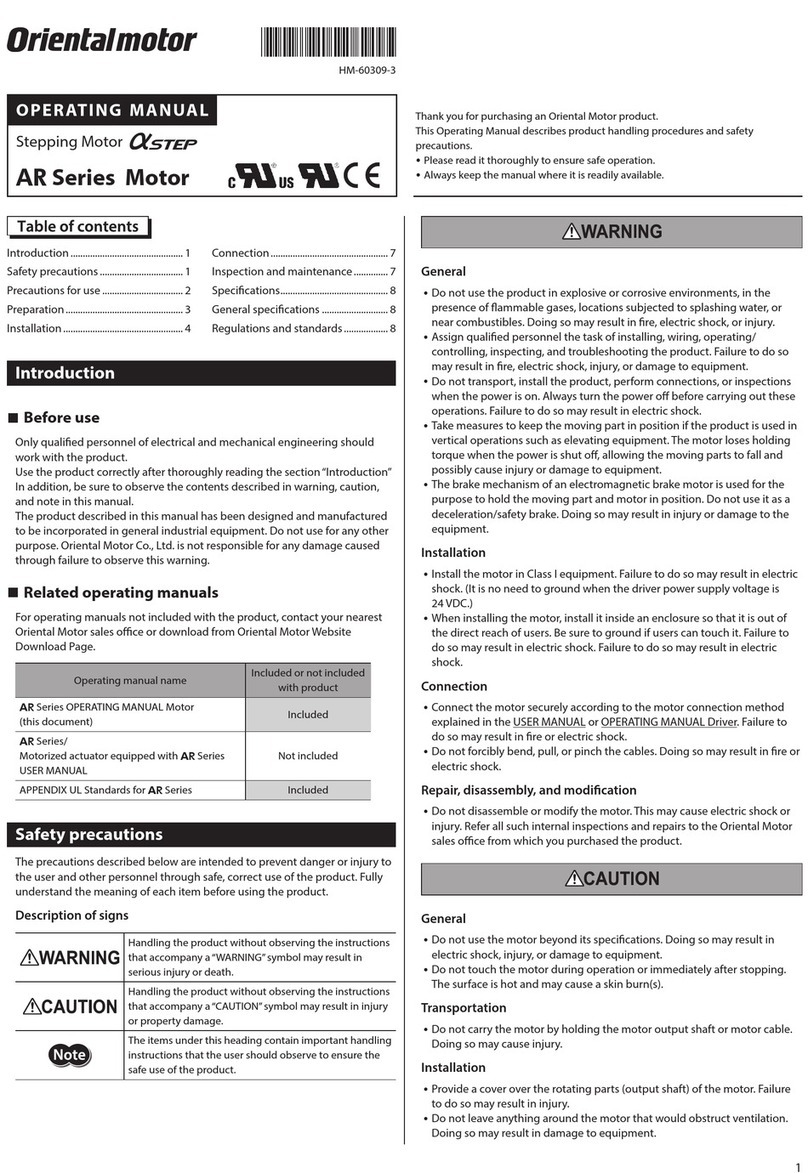
Oriental motor
Oriental motor aStep ARM24 operating manual
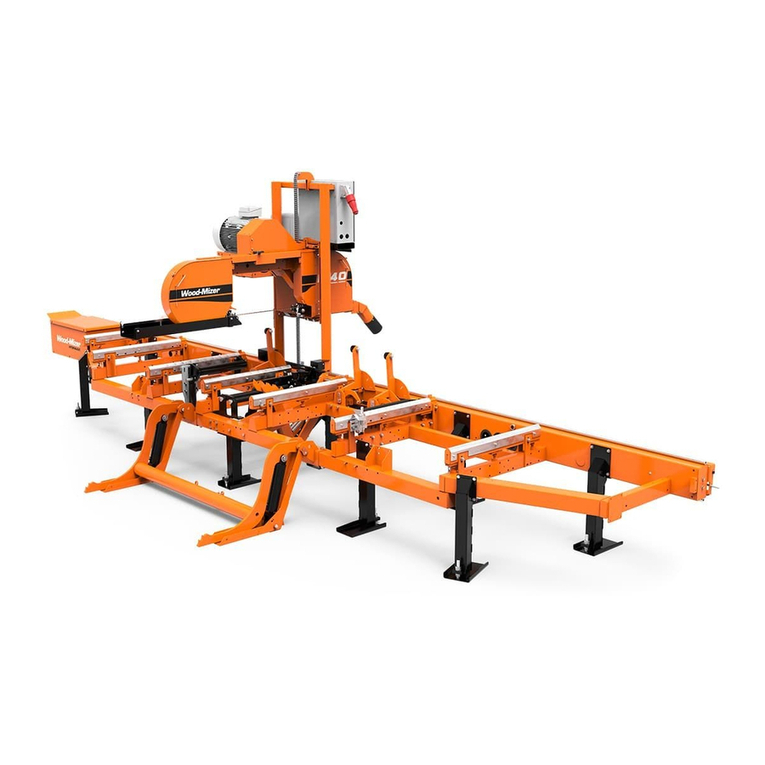
woodmizer
woodmizer LT30 Safety, Operation, Maintenance & Parts Manual

Oriental motor
Oriental motor NX Series operating manual

Vanguard
Vanguard 540000 Series Operator's manual
